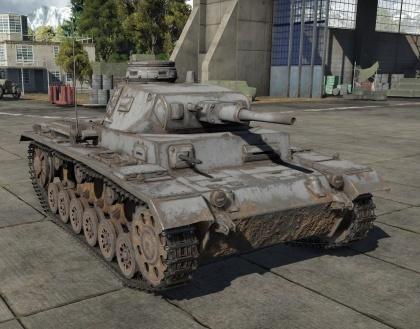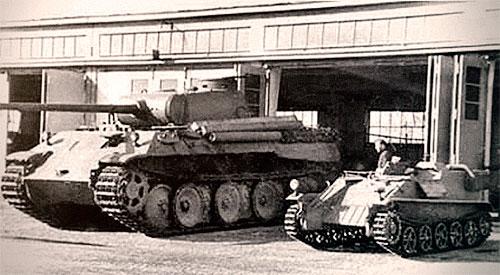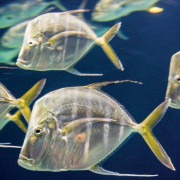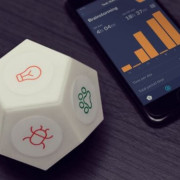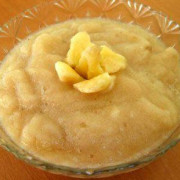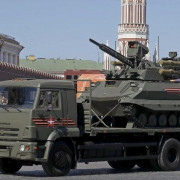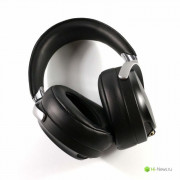Тип 10
Содержание:
- So what’s changed?
- Видео обзоры Type 5 Heavy
- Система управления огнём (СУО)
- Японский танк Тип 10 — видео
- Links & Resources
- Type 11 ARV
- См. также
- Type 91 Heavy в игре
- Usage in battles
- Why build a tank?
- General info
- Орудие
- Двигатель и трансмиссия
- Вооружение
- What we (think we) know so far…
- Stuff we didn’t know
- Description
- Mobility
So what’s changed?
We now know the cost will be 124,755,342 CR, which as theorised, is between the Anaconda and Type-9 stablemate. The Defender image shows the little winglets deployed and a very noticeable spoiler (which we saw in photos at the the Frontier Expo and assumed was a ship kit).
The ship description is:
The hardpoints are not the same as previously thought, with 4 large, 4 small (not 1) and 1 medium (not 3) which lowers the calculated firepower factor to 18 (from 20) and with the core internals being identical to the Type-9, the FSD and power plant are the same. This is not-so-good news. It means this beasty will be armoured out the wazoo, but will fly like a whale and while it’s firepower theoretically could match a cutter, it lacks the power systems to run many energy weapons, so this will rely on kinetic weapons to keep the hurt coming in combat.
Thanks to the description we know this will be the first Alliance ship in the game.
Strangely for this heavier (and lower jump range) variant of the Type-9, the cruise and boost speeds are higher! Does this mean the ship will be more agile than the Type-9? Maybe. But unless it is impossibly agile, then this ship is going to rely heavily on turrets and the deployed SLF.
It won’t outrun a Thargoid (or anything else for that matter) but it will probably take extreme amounts of punishment and still limp away.
As long as the power-plant will take it, Class 8 shields plus all that armour will make it THE in-game ship-tank. People are going to have a lot of fun in outfitting with this one.
| Type-10 Defender | Type-9 Heavy | |
|---|---|---|
|
Top speed |
179m/s |
131m/s |
|
Boost speed |
219m/s |
201m/s |
|
Manoeuvrability |
— |
— |
|
FSD Range laden |
5.67 Ly |
6.62ly |
|
FSD Range unladen |
6.87 Ly |
7.71ly |
|
Shields |
88 |
88 |
|
Armour |
1,044 |
864 |
|
Hull mass |
1,200T |
1000T |
|
Cargo Capacity |
220T |
220T |
|
Hardpoints |
4 Small |
2 Small |
|
1 Medium |
3 Medium |
|
|
4 Large |
— |
|
|
Utility slots |
8 |
4 |
|
Optional internal |
Class 8: 7E Cargo rack |
Class 8: 7E Cargo rack |
|
Class 7: 6E Cargo rack |
Class 7: 6E Cargo rack |
|
|
Class 6: 6E Shield Generator |
Class 6: 6E Shield Generator |
|
|
Class 5: 4E Cargo rack |
Class 5: 4E Cargo rack |
|
|
Class 4: 3E Cargo rack |
Class 4: 3E Cargo rack |
|
|
Class 4: Empty |
Class 4: Empty |
|
|
Class 3: 2E Cargo rack |
Class 3: 2E Cargo rack |
|
|
Class 3: Empty |
Class 3: Empty |
|
| Military slot (unconfirmed) | — | |
| Military slot (unconfirmed) |
— |
|
|
1E Basic discovery scanner |
Class 2: 1E Basic discovery scanner |
|
|
1I Planetary approach suite |
1I Planetary approach suite |
|
|
Core Internal |
1C Lightweight alloys |
1C Lightweight alloys |
|
6E Power Plant |
6E Power Plant |
|
|
7E Thrusters |
7E Thrusters |
|
|
6E Frame shift drive |
6E Frame shift drive |
|
|
5E Life support |
5E Life support |
|
|
6E Power distributor |
6E Power distributor |
|
|
4E Sensors |
4E Sensors |
|
|
6C Fuel tank |
6C Fuel tank |
Видео обзоры Type 5 Heavy
Читайте далее:
КВ-122 — советский премиум танк 7 уровня WOT
Т92 — легкий американский танк VIII уровня WOT
Panther/M10 — немецкий средний танк WOT
Pz.Kpfw. VII — тяжелый немецкий танк 10 уровня WOT
WZ-111 model 5А — мощный китайский ТТ 10 уровня WOT
T110E4 -американская ПТ-САУ 10 уровня WOT
Система управления огнём (СУО)
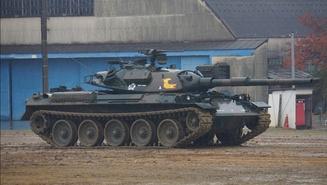
Type 74 на учениях
Система управления огнем включает лазерный прицел-дальномер командира, основной и дополнительный прицелы наводчика, стабилизатор, баллистический вычислитель, пульты управления командира и наводчика, приводы управления. Функции измерения дальности и подготовки данных для стрельбы возложены на командира. Он пользуется комбинированным (день-ночь) перископическим прицелом, в который встроен лазерный дальномер на рубине, измеряющий дальность в пределах от 300 до 4000 метров с точностью десять метров. Прицел имеет восьмикратное увеличение и связан с пушкой с помощью параллелограммного устройства. Для кругового обзора предусмотрено пять перископических смотровых приборов, установленных по периметру основания командирского люка.
Наводчик пользуется основным комбинированным (день-ночь) перископическим прицелом с восьмикратным увеличением и вспомогательным комбинированным телескопическим прицелом. Ночные приборы активного типа, подсветка производится с помощью ксенонового прожектора, установленного слева от маски пушки.
Двухплоскостной стабилизатор с электромеханическим приводом наводки обеспечивает ведение огня из пушки и спаренного пулемета как наводчиком, так и командиром с помощью одинаковых пультов управления. Наводчик может использовать, кроме того, дублирующий ручной привод наводки по вертикали и по горизонту.
Японский танк Тип 10 — видео
https://youtube.com/watch?v=Kf_NN7_Q-v4
13 февраля 2008 года в Японии состоялась публичная демонстрация танка нового поколения, который вобрал в себя все наиболее современные конструкторские решения в области танкостроения и был создам с учетом опыта ведения локальных конфликтов последних лет. Прототип перспективного ОБТ был представлен журналистам в исследовательском центре Министерства обороны Японии в городе Сагамихара. Как и предшественники, новая машина имеет гидропневматическую подвеску, позволяющую менять клиренс танка и наклонять его на левый или правый борт
Обращает на себя внимание сокращенное по сравнению с танком «90» количество катков — по 5 на борт, при этом расстояние между ними больше. В целом по внешнему виду подвески новый танк напоминает ОБТ «74».Новая машина вобрала в себя все наиболее современные наработки в области танкостроения
Танк оснащен электронной системой C4I, совмещающей возможности управления, наведения, связи и разведки. Система позволяет осуществлять автоматический обмен информацией между танками. СУО танка позволяет эффективно бороться с мелкими подвижными целями. Эта функция в сочетании с современной модульной композитной системой бронирования, как утверждается, позволит танку одинаково успешно действовать в бою как с армиями, имеющими современные ОБТ, так и с партизанскими формированиями, основными противотанковыми средствами которых являются ручные противотанковые гранатометы. В репортаже японского телевидения о новой машине значительное внимание было уделено как раз «антитеррористическому» потенциалу танка и его защите от различных разновидностей РПГ-7.
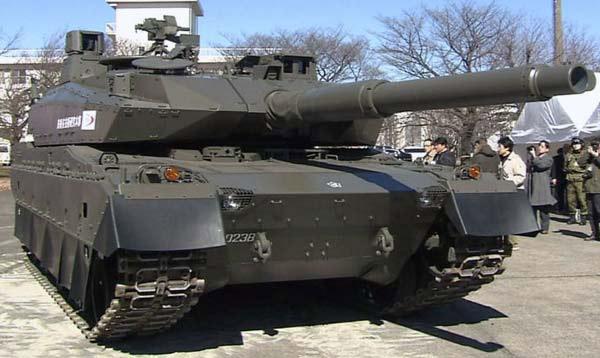
Во внешнем облике танка «10» прослеживаются общие черты с такими современными ОБТ, как Leopard 2А6 и Merkava Mk 4. Но по габаритам и массе он ближе к российским танкам. Надо отметить, что еcли по составу вооружения, подвижности танк «10» соответствует принятому на вооружение в 1989 голу танку «90», а по возможностям системы управления огнем и другого электронного оборудования, по всей видимости, должен его превосходить, то по габаритам и весу он меньше и ближе к танку «74». Надо отметить, что основной претензией японских военных к танку «90» была как раз его высокая стоимость — 7,4 млн. долларов, на 3 млн. дороже, чем цена американского «Абрамса», а также массо-габаритные характеристики, препятствующие свободной транспортировке танков железнодорожным транспортом и самостоятельному передвижению по дорогам внутри страны. Так что при создании нового танка Mitsubishi Heavy Industries Ltd. выполнила пожелания военных и разработала более дешевый и компактный вариант.
Стоимость одной боевой машины составляет около 700 млн. йен, или примерно 6.5 млн. долларов. Как отметил в ходе презентации представитель военного ведомства Японии, объем заказа на танк пока не определен. Крупнейший японский холдинг Mitsubishi Heavy Industries Lid., являющийся разработчиком танка, рассчитывает в ближайшее время заключить контракт стоимостью 48,4 млрд. йен на производство новых танков. Их серийное изготовление планировалось начать в 2010 голу. Однако, судя по последним сообщениям, этот срок отложен до 2014 года в связи с некоторыми проблемами, выявленными в ходе испытаний.
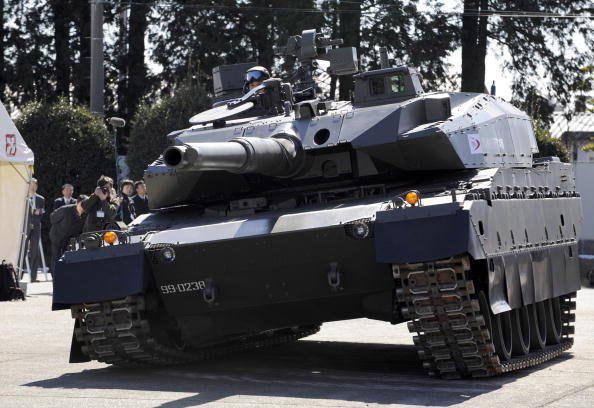
Огневая мощь
Основным вооружением танка является 120-мм немецкая пушка Rheinmetall, имеющая длину ствола 44 калибров и снабжённая автоматом заряжания конвейерного типа. Пушка оснащена эжектором пороховых газов, термокожухом и стабилизирована в двух плоскостях.
Особое внимание японские конструкторы уделили БИУС (боевая информационно-управляющая система) и ТИУС (танковая информационно-управляющая система). Танк оснащается эффективной системой панорамного обзора
Защищённость
Модульная конструкция брони предусматривает возможность замены повреждённых модулей и установку дополнительных навесных модулей на бортовые экраны корпуса, что увеличивает защищённость и увеличивает боевой вес машины до 48 тонн. передняя вставка танка обеспечивает ему плаванье на воде со средней скоростью 13 км/ч.
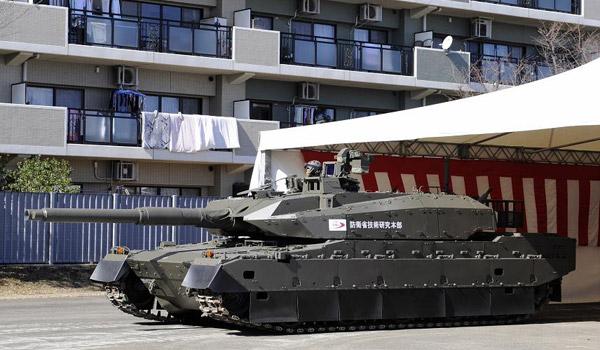
Подвижность
Оснащается дизельным двигателем мощностью 1200 л.с., что обеспечивает высокую удельную мощность (27 л.с./т). Трансмиссия танка — автоматическая бесступенчатая, позволяющая развивать 70 км/ч как вперёд, так и назад.
Links & Resources
Postwar Japanese Tanks, Kamado Publishing, Aug. 2009.Tankograd Publishing, JGSDF: Vehicles of the Modern Japanese Army, Koji Miyake & Gordon ArthurTankograd Publishing, In Detail, Fast Track #6: Type 10TK, Hitomaru-Shiki-Sensha, Koji Miyake & Gordon ArthurThe Type 10 on Japan’s Ministry of Defense website News report on the Type 10The Type 10 on GlobalSecurity.orgThe Japanese Ground Self Defense Force (JGSDF) website
 Type 10 Hitomaru of the 1st Tank Battalion, 1st Division of the Eastern Army.
Type 10 Hitomaru of the 1st Tank Battalion, 1st Division of the Eastern Army.
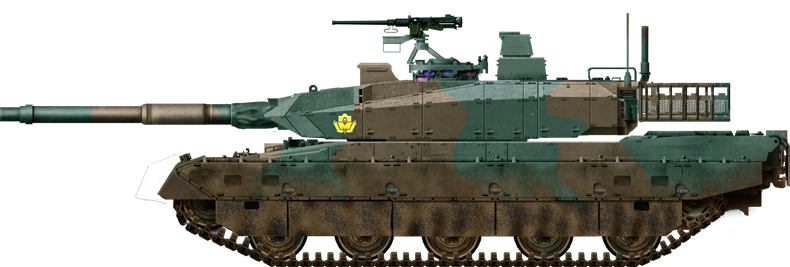 Type 10 with add-on armour from the 5th Tank Battalion, 5th Brigade of the Northern Army.
Type 10 with add-on armour from the 5th Tank Battalion, 5th Brigade of the Northern Army.
These 1/72 scale illustrations were done by Tanks Encyclopedia’s own David Bocquelet.

Type 11 ARV
The Type 11 Armored Recovery Vehicle (ARV), is currently the only variant of the Type 10 Hitomaru. The driver and commander share a single compartment on the left front of the vehicle. On the right is a large heavy-lift boom. The vehicle retains the hydropneumatic suspension, allowing it lower if necessary for ease of vehicle recovery. The vehicle also carries a Browning M2HB .50 cal for personal defense.
Crowds of people had a demonstration of its capabilities at one of the displays at Fuji during which a Type 10 slipped a track during a rapid change of direction and so required the used of the Type 11 to rescue it.
См. также
Сравнительные ТТХ современных основных танков
|
Т-90А «Владимир» |
БМ «Оплот» |
M1A2 SEP Абрамс |
Леопард 2A6M |
AMX-56 Леклерк |
Челленджер 2 |
C1 Ариете |
PT-91 Тварды |
|---|
| Внешний вид | ||||||||
| Год принятия на вооружение | 2005 | 2009 | 2000 | 2004 | 1992 | 2002 | 1995 | 2010 |
| Боевая масса, т | 46,5 | 51,0 | 63,0 | 68,5 | 54,6 | 62,5 | 54,0 | 45,5 |
| Экипаж | 3 | 3 | 4 | 4 | 3 | 4 | 4 | 3 |
| Калибр пушки, мм | 125 | 125 | 120 | 120 | 120 | 120 | 120 | 125 |
| Панорамный прицел | нет | ПНК-6 | есть | PERI-R-12 | SFIM VS-580 | SFIM VS-580 | ATTILA | нет |
| Управляемое вооружение | Рефлекс-М | Комбат | нет | нет | нет | нет | нет | нет |
| Боекомплект, выстрелов | 43 | 46 | 42 | 42 | 40 | 52 | 42 | 40 |
| Скорострельность, выстр/мин | 7 | 8 | н/д | н/д | 10—12 | н/д | н/д | 7 |
| Динамическая защита | Контакт-5 | Дуплет | TUSK ARAT | есть | нет | ROMOR | PSO/WAR | ERAWA |
| Активная защита | Штора-1 | Варта | AN/VLQ-6 MCD / Трофи | MUSS | н/д | н/д | н/д | OBRA-3 |
| Мощность двигателя, л. с. | 1000 | 1200 | 1500 | 1500 | 1500 | 1200 | 1300 | 1000 |
| Удельная мощность, л. с./т | 21,5 | 23,5 | 23,8 | 24,0 | 27,5 | 19,2 | 24,1 | 22,0 |
| Максимальная скорость, км/ч | 60…70 | 70 | 67 | 72 | 72 | 56 | 65 | 65 |
| Запас хода по шоссе, км | 550…700 | 500 | 425 | 550 | 550 | 400 | 550 | 480 |
|
Меркава Mk.4М |
Арджун Mk.I |
Аль-Халид |
Каррар |
Сонгун-915 |
К2 «Чёрная пантера» |
ZTZ-99А2 |
Тип 10 |
|---|
| Внешний вид | ||||||||
| Год принятия на вооружение | 2009 | 2011 | 2001 | 2017 | 2009 | 2014 | 2011 | 2012 |
| Боевая масса, т | 65,0 | 58,5 | 48,0 | 51,0 | 44 | 55,0 | 58,0 | 44,0 |
| Экипаж | 4 | 4 | 3 | 3 | н/д | 3 | 3 | 3 |
| Калибр пушки, мм | 120 | 120 | 125 | 125 | 125 | 120 | 125 | 120 |
| Панорамный прицел | есть | нет | есть | н/д | нет | есть | есть | есть |
| Управляемое вооружение | LAHAT | LAHAT | нет | н/д | Bulsae-3 | KSTAM | Рефлекс | нет |
| Боекомплект, выстрелов | 48 | 39 | 39 | н/д | н/д | н/д | 41 | н/д |
| Скорострельность, выстр/мин | н/д | 6—8 | 8 | н/д | н/д | 10 | 7 | н/д |
| Динамическая защита | есть | нет | есть | есть | есть | есть | есть | нет |
| Активная защита | Трофи | нет | Варта | ERA | нет | есть | JD-3 | н/д |
| Мощность двигателя, л. с. | 1500 | 1400 | 1200 | н/д | 1200 | 1500 | 1500 | 1200 |
| Удельная мощность, л. с./т | 23,5 | 23,9 | 25,0 | н/д | 27,3 | 27,3 | 25,9 | 27,3 |
| Максимальная скорость, км/ч | 70 | 70 | 70 | 70 | 70 | 70 | 70 | 70 |
| Запас хода по шоссе, км | 500 | 450 | 500 | 550 | н/д | 450 | 450 | н/д |
Type 91 Heavy в игре
Исследование и прокачка
Эта машина является техникой и не требует исследования.
| Ходовая | |
| Type 91 Heavy | |
380 2200
| Орудие | |
| 47 mm Gun Type 1 | |
1200 21000
| Двигатель | |
| BMW IV Kai | |
280 7800
| Радиостанция | |
| Type 94 Mk. 4 Hei | |
430 2350
| Радиостанция | |
| Type 96 Mk. 4 Bo | |
1400 14000
| Итог: | |
| Кредиты: | 47350 |
| Опыт: | 3690 |
- Комментарии к прокачке
- Ходовая добавит грузоподъемности, а также увеличит манёвренность танка.
- Орудие улучшит пробитие, скорострельность и точность.
- Двигатель немного повысит динамику.
- Радиостанция увеличит дальность связи. Может остаться с Type 89 I-Go/Chi-Ro.
- Радиостанция ещё увеличит дальность связи. Может остаться с Type 89 I-Go/Chi-Ro.
Боевая эффективность
- Достоинства:
- выбор из 47 мм «дырокола» и 70 мм «фугасницы»;
- хорошие УВН;
- большой боекомплект;
- хорошая скорострельность 47 мм орудия;
- хорошая бронепробиваемость 47 мм орудия.
- Недостатки:
- посредственная динамика;
- отсутствие брони, несмотря на звание тяжелого танка;
- большие габариты;
- посредственная точность орудий;
- посредственная дальность связи.
Экипаж
- Боевое братство повысит всех характеристики машины.
- Шестое чувство позволит понять, обнаружен ли танк или нет.
- Маскировка повысит незаметность, в дополнение можно нанести камуфляж.
- Ремонт ускорит починку модулей.
- Комбинация Радиоперехват + Орлиный глаз даст прибавку к обзору в 5%.
- Комбинация Плавный ход + Плавный поворот башни позволит либо быстрее сводиться на цель после смены позиции, либо точнее стрелять на ходу.
- Король бездорожья немного улучшит подвижность по слабым грунтам.
- Изобретатель повысит дальность связи.
Оборудование, снаряжение и боекомплект
top
ББ125
ББ25
ОФ
- Оборудование
- Усиленные приводы наводки — позволят быстрее сводиться.
- Просветленная оптика — увеличит дальность обзора.
- Улучшенная вентиляция — улучшит все основные характеристики танка.
- Снаряжение
Стандартный набор снаряжения: ремкомплект, аптечка и огнетушитель. Горит танк редко, поэтому огнетушитель можно заменить на Онигири.
- Боекомплект
Основную часть боекомплекта составляют бронебойные снаряды, имеет смысл возить несколько премиумных бронебойных снарядов для встречи с бронированными противниками. Осколочно-фугасные снаряды такого калибра совершенно неэффективны.
1
ББ10
КС15
ОФ75
- Оборудование
- Усиленные приводы наводки — позволят быстрее сводиться.
- Стереотруба — чтобы светить врагов раньше, чем они заметят вас.
- Маскировочная сеть — уменьшит заметность неподвижного танка.
- Снаряжение
Стандартный набор снаряжения — ремкомплект, аптечка и огнетушитель. Горит танк редко, поэтому огнетушитель можно заменить на Онигири.
- Боекомплект
Основную часть боекомплекта составляют осколочно-фугасные снаряды. Бронебойные и кумулятивные снаряды ввиду короткой длины ствола эффективны только в ближнем бою.
47 мм «дырокол»
1
70 мм «фугасница»
История изменений
-
Основная статья: История изменений Type 91 Heavy
История изменений
- Обновление 0.9.10
Введён на основной сервер в качестве японского тяжёлого танка 3 уровня.
- Обновление 0.9.15
- Разброс орудия от движения ходовой Dai-chi Osaka Sensha уменьшен на 15%.
- Разброс орудия от поворота ходовой Dai-chi Osaka Sensha уменьшен на 15%.
- Разброс орудия от движения ходовой Type 91 Heavy уменьшен на 17%.
- Разброс орудия от поворота ходовой Type 91 Heavy уменьшен на 17%.
- Время перезарядки орудия 47 mm Gun Type 1 для башни Type 91 Heavy уменьшено с 2,2 до 2,1 с.
- Время прицеливания орудия 7 cm Gun Type 94 для башни Type 91 Heavy уменьшено с 2,8 до 2,6 с.
- Время перезарядки орудия 7 cm Gun Type 94 для башни Type 91 Heavy уменьшено с 4,2 до 4 с.
- Разброс орудия 7 cm Gun Type 94 уменьшен с 0,52 до 0,48 м.
- Обновление 1.9
- Боезапас орудия 47 mm Gun Type 1 изменён с 150 до 265 снарядов.
- Боезапас орудия 7 cm Gun Type 94 изменён с 100 до 175 снарядов.
- Стоимость ремонта уменьшена на 44%.
- Доходность уменьшена на 12%.
- Прочность с башней Type 91 Heavy изменена с 250 до 445 единиц.
Usage in battles
The Type 74G is a classic MBT with good mobility and firepower. It’s fast enough to be somewhat competitive with its peers (although low-speed acceleration and maneuverability are lacking, which makes urban fighting sometimes tedious), and can sometimes reach favourable early-game positions before the enemy. The Type 74G is slower than the AMX-30 Super, OF-40 (MTCA), and most IFVs, so watch out for those tanks in situations where mobility is required. The Type 74G’s reverse speed is mediocre, so peeking an enemy in order to take a shot can be dangerous; the enemy may have time to fire back before the Type 74G can retreat into cover. All in all, this tank has good mobility, but it can’t be depended on in a pinch, and it certainly doesn’t give the Type 74G a significant advantage over the enemy.
The armour on the Type 74 is nothing special and shouldn’t be relied on to survive a shot from the enemy. Any APFSDS shell can penetrate the Type 74G’s armour from practically any angle. It is therefore better to not get hit by an enemy tank shell to begin with. The armour’s only merit is being able to resist machine gun and autocannon rounds from light tanks or IFVs such as the BMP-2, which can buy precious seconds for the Type 74G to retaliate before the enemy gets a good shot. With four crew members, the survivability of the Type 74G after penetration is on-par with other tank designs from USA and Germany. The prominence of APFSDS shells in this rank combined with the thin armour of the Type 74G can mean instances where an APFSDS penetrates the armour and goes right through with minimal shrapnel damage, and so relatively little interior damage outside of the APFSDS’ direct flight path.
With the Type 74G, it is recommended to take no more than 15 shells into battle, since these first 15 shells are stored in a relatively safe compartment in the turret. With these shells, the tank is able to penetrate most enemy tanks except at very long ranges. The Type 93 APFSDS shell is one of the best at this tier, and a quick reload time lets the Type 74G be a deadly weapon on the battlefield. The Type 74G has a worse rotation than most Western MBTs, although it is better that that of Russian tanks. This difference can mean the difference between life and death in situations where quick aiming is important. This tank is also able to use a pneumatic suspension system to lower or raise its hull on its suspension. This is useful when firing from behind cover. The Type 74G can go fully hull-down when behind a ridgeline, and ridgeline sniping is therefore one of this vehicle’s strengths. While it’s not recommended, it is possible to use the tank’s 12.7 mm machine gun to fight light tanks like the AUBL/74 HVG.
Modules
| Tier | Mobility | Protection | Firepower | |||
|---|---|---|---|---|---|---|
| I | Tracks | Parts | Horizontal Drive | Type 75 | ||
| II | Suspension | Brake System | FPE | Adjustment of Fire | Type 91 | Laser rangefinder |
| III | Filters | Crew Replenishment | Elevation Mechanism | M416 | ||
| IV | Transmission | Engine | Smoke grenade | Artillery Support | Type 93 | NVD |
| This is a premium vehicle: all modifications are unlocked on purchase |
Pros and cons
Pros:
- Decent mobility, enough to be competitive and reach most of your favourite positions
- Very good APFSDS shell (Type 93) — one of the best in its rank
- Good lineup with Type 89, Type 87 and regular Type 74
- Some armour to stop autocannons from IFVs and MBTs, such as the BMP-2, XM803, MBT-70 and the French tanks with 20 mm coax guns
- Pneumatic suspension
Cons:
- Slower than for example Leopard A1A1 or OF-40, and quite a bit slower than AMX-30 Super and OF-40 MTCA
- Worse turret rotation than other western MBTs, but still better than Russians
- Mediocre reverse speed at only 14 kph compared to the mentioned competitors
- Generally a little bit more sluggish in the steering than the other Nations MBTs
Why build a tank?
It might seem curious that so many countries around the world go through all the trouble of designing and building their own indigenous tank. At a superficial glance, it might seem to be easier and more cost effective to simply buy an already proven design from another country.
However, this is not the case for a lot of countries. Tanks are very expensive high-end products. Building it locally means that all the money invested in the designing and construction stays within the local economy. It pays local people and local companies, which pay taxes to the state, so the money invested in such a military asset eventually return to the government as taxes.
Furthermore, such an investment creates jobs for a significant amount of people, ranging from engineers, scientists, programmers and construction workers. These are positions that require skilled employees, which are vital to the development of most countries.
The construction and designing of a new tank also imply the creation or integration of high-end technologies. However, these can be then also transferred into the civilian economy, leading to the production of more valuable goods. A tank requires a whole suite of different technologies that can then find their way into civilian use, from the suspension to advanced materials used in its construction, electronics, programming, various sensors or the powerful powerpack. Add to that the nationalism of developing and fielding your own tank with secure lines of supply etc. and even with the very high cost of the Type 10 it makes a little more sense.
Video from the 2014 Firepower in Fuji event at the JGSDF’s Guji training ground featuring the Type 10. It is accompanied by Type 89 IFVs and Type 87 SPAAGs.
General info
Survivability and armour
Armour type:
- Rolled homogeneous armour (Hull, Side skirts)
- Cast homogeneous armour (Turret, Gun mantlet, Cupola)
| Armour | Front (Slope angle) | Sides | Rear | Roof |
|---|---|---|---|---|
| Hull | 40 mm (73°) Front glacis — upper section 80 mm (64°) Front glacis — lower section 80 mm (57°) Lower glacis 50 mm Hull over the tracks 50 mm Driver port | 50 mm (44°) Top — front part 35 mm (44°) Top — center and rear parts 30 mm Bottom 10 mm Side skirts 10 mm (55°) Belly | 20 mm Top 20 mm (47°) Bottom | 25 mm |
| Turret | 132 mm (25°) Turret front 200 mm (40°) Gun mantlet — upper section 100 mm Gun mantlet — lower section | 132 mm (30°) Front half 67 mm (40°) Rear half | 37 mm (18°) Vertical part 40 mm (70°) Turret ring area | 67 mm (82°) Front 37 mm Rear |
| Cupola | 80 mm (61°) | 80 mm (55°) | 80 mm |
Notes:
- Suspension wheels and tracks are 20 mm thick.
- Frontally, the driver port as well as the hull over the tracks are weak spots on the Type 74G.
- The bottom of the hull is only 10 mm thick, making it vulnerable to powerful HE shells shot under the belly.
The armour on the Type 74 is nothing special and shouldn’t be relied upon to surviving a shot from the enemy. It is therefore better to not get hit by an enemy tank shell to begin with. Its only merit is being able to resist autocannon rounds from light tanks or IFVs, which can buy precious seconds for the Type 74G to retaliate before the enemy gets a good shot.
With four crew members, the survivability of the Type 74G after penetration is on-par with other tank designs from USA and Germany. The prominence of APFSDS shells in this rank combined with the thin armour of the Type 74G can mean instances where an APFSDS penetrates the armour and goes right through with minimal shrapnel damage, and so relatively little interior damage outside of the APFSDS’ direct flight path.
The special thing about this tank is its pneumatic suspension. It give you the possibility to be fully hull-down on mountains. That capacity can make the Type 74G less visible and therefore less exposed to enemy fire.
Mobility
| Game Mode | Max Speed (km/h) | Weight (tons) | Engine power (horsepower) | Power-to-weight ratio (hp/ton) | |||
|---|---|---|---|---|---|---|---|
| Forward | Reverse | Stock | Upgraded | Stock | Upgraded | ||
| Arcade | 59 | 18 | 38.5 | 1116 | 1,374 | 28.99 | 35.69 |
| Realistic | 53 | 16 | 637 | 720 | 16.55 | 18.7 |
The Type 74G’s mobility is pretty decent and comparable to the OF-40 Mk 2 or Leopard A1A1, but slightly slower. The Type 74G however has a reverse speed of only -14 km/h against -25 km/h for the previously mentioned tanks.
While the Type 74G can outspeed Russian, British and most American medium tanks, don’t expect to be faster than a BMP, TAM, Bradley or the faster premiums like OF-40 MTCA or AMX-30 Super.
Орудие

15 cm/45 41st Year Type
Обновление 0.9.17.1 коснулось и самого интересного – вооружения. Машина имеет просто невероятный альфастрайк, из-за чего только показавшись в бою, вызывает страх. Урон у японца – 1 100/1 400/0 единиц.
Скорострельность не такая, какой бы хотелось ее видеть. Всего 3 выстрела в минуту. Разброс тоже ожидаемо огромный – 0,50 на 100 метров. Стабилизация хромает, а время сведения – 2,90 секунды.
А вот углы вертикальной наводки радуют. Пушка может опуститься вниз на 10 градусов. Очень хороший и, главное, комфортный результат.
У нашего танка имеется и альтернативная оружие – всем известная пушка. Она отличается от предыдущего орудия менее мощным альфастрайком, однако показатель скорострельности выше.

14 cm/50 3rd Year Type
Урон у этой пушки почти вдвое меньше – 600/600/700 единиц, скорострельность -3,51 выстрела в минуту. Отсюда получаем более стабильный урон в минуту – 2 105 ед/мин.
Точность у данной пушки определенно лучше, время сведения меньше – 2,50 секунды, а разброс составляет 0,40 на 100 метров. Стабилизация по-прежнему остается не очень хорошей.
Орудие каждый танкист может выбрать на свой вкус. Может быть, фугасница станет более выгодной в качестве стабильно наносящей урон, она не требует точного выцеливания, но, согласитесь, не каждый идет по наиболее легкому пути. Выбор только за вами.
Двигатель и трансмиссия

Type 74 на учениях
В кормовой части в МТО размещены в едином силовом блоке двигатель с трансмиссией и обслуживающими системами, а также два топливных бака и четыре аккумулятора.
На танке установлен двухтактный V-образный десятицилиндровый многотопливный дизель воздушного охлаждения мощностью 550 кВт (750 л.с.). На двигателе смонтированы два осевых вентилятора и кожухи для направления потока охлаждающего воздуха. В передней части двигателя установлены два турбокомпрессора, каждый из которых имеет связь с коленчатым валом, что обеспечивает необходимую раскрутку компрессора при пуске двигателя.
Трансмиссия МТ7SА фирмы «Мицубиси» механическая, планетарная, с фрикционным включением передач (шести переднего и одной заднего хода) и дифференциальным механизмом поворота
Вооружение
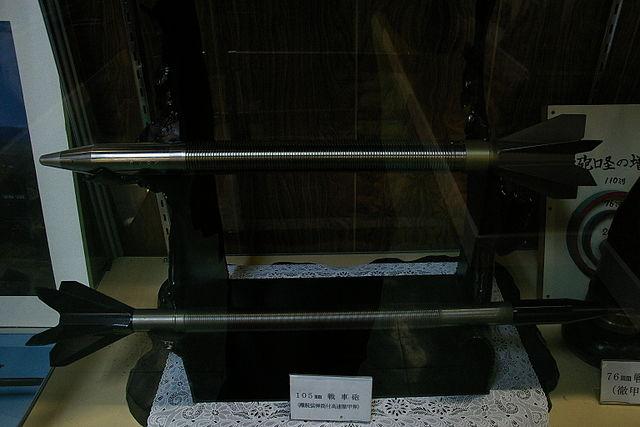
Сердечник БОПС 105-мм пушки Royal Ordnance L7 танка Тип 74.
Основным вооружением является английская 105-мм нарезная пушка с концентрическими противооткатными устройствами, которая производится в Японии по лицензии. Оснащалась термозащитным кожухом ствола.
Первоначально в боекомплект танка Тип 74 входили два типа выстрелов: бронебойные подкалиберные (типа англ. APDS) и бронебойно-фугасные снаряды с пластичным ВВ (англ. HESH), всего 55 выстрелов. Большая часть боекомплекта размещена в корпусе справа от водителя, меньшая — в кормовой нише башни.
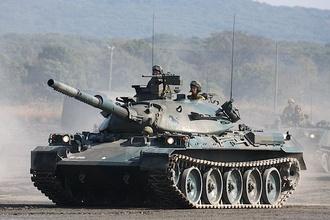
Тип 74 на учениях
Позднее в боекомплект были введены более эффективные выстрелы типов БОПС и кумулятивно-осколочный многоцелевой (англ. HEAT-MP).
С пушкой спарен 7,62-мм пулемет с боекомплектом 4500 патронов. Между люками командира и заряжающего на кронштейне установлен открыто-расположенный 12,7-мм зенитный пулемет. Огонь из пулемета может вести как заряжающий, так и командир. Боекомплект 600 патронов. По бортам кормовой части башни установлено по три дымовых гранатомета калибра 60 мм.
What we (think we) know so far…
The Type-10 Defender is a Lakon ship and a variant of the Type-9 Heavy transport ship. We’ve seen clips of the ship in Frontier’s Beyond teaser video and it has a lot more engine power on display than it’s stable-mate.
Recently a CMDR anonymously posted game-data mined from Elite: Dangerous that reveals yet more details of this as-yet-unreleased ship. The data gives us a wealth of information about the ship and it’s place in the game.
Stuff we didn’t know
The ship designation in the game code is “TYPE-9_MILITARY/FORC_FDEV_V_MAMMOTH”
The internals are as follows: —
- Class 8 Power plant (Class 6 on the Type 9)
- Class 7 Thrusters (same as Type 9)
- Class 7 Frame Shift Drive (Class 6 on Type 9)
- Class 5 Life Support (same as Type 9)
- Class 6 Power Distributor (same as Type 9)
- Class 4 Sensors (same as Type 9)
- Class 6 Fuel tank (same as Type 9)
UPDATED thanks to Reddit for spotting my error — I had compared to Type-7 (I think) — I plead old age!
The Class 8 power plant puts the T10 right up there with the Cutter, Corvette and Anaconda. The Class 6 power distributor, same as the Type-9, seems a little low, but this ship doesn’t have any Huge hard-points, so maybe a Class 7 wasn’t required — either that or they are trying to limit the ship to kinetic weapons only which draw less power. The Class 7 FSD is a winner for sure, as only the Cutter and Beluga (the two largest ships in the game) have this size of Frame Shift and this vessel is smaller than a Type 9! That means this ship might have a reasonable jump range – especially for a combat class vessel that may have to ship out to Merope.
Description
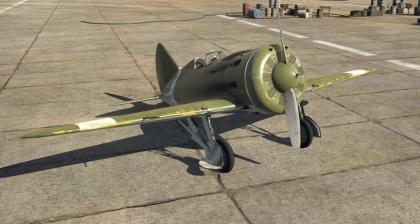
The I-16 type 10 Ishak is a rank I Soviet fighter
with a battle rating of 1.7 (AB/RB/SB). It was introduced in Update 1.45 «Steel Generals».
The I-16 Type 10 is equipped with four ShKAS machine guns chambered with the 7.62 x 54R cartridge, a cyclic rate of fire of 1,800 rpm. Two of them are mounted above the engine cowling and carry 650 RPG while other pair are mounted on the wings and have ammo load out of 900 rounds each. Historically the cowling mounted machine guns were synchronized to propeller spin resulting in a rate of fire of 1,460 rpm, the preliminary analysis seems to suggest that the synchronization gear is not modelled in the game and all four guns fire at 1,800 rpm.
While the increase of the armament by double may seem already quite an upgrade it has to be remembered that the extra pair of light machine guns are fitted in the cowling, which means that convergence range is not quite as important for effective fire when compared to the wing mounted only armament of the Type 5. Of course, it is still not to be neglected, and as with any light machine gun armed vehicle, a relatively close gun convergence range of 150 to 400 meters is generally more effective. As with any other ShKAS machine gun armed aircraft, jamming due to overheat can be a serious threat although not quite as crippling as it is with the Type 5’s (losing a machine gun in Type 5 means losing 1/2 of your firepower, losing one in Type 10 mean losing «only» 1/4 of your firepower). Unlike the I-16 Type 5, Type 10 is equipped with a PAK-1 reflector sight making overall aiming at close range easier than with a telescopic sight. It has to be kept in mind that in spite of the increased weight and more powerful armament, the lack of trimmer control and plane’s inherent stability make it a rather lousy gun platform compared to latter heavier aircraft.
Unlike the Type 5 that precedes it, Type 10 does have the ability to mount armament on its external pylons. This armament in-game is limited to six wing-mounted RS-82 rockets, unfortunately these rockets had a somewhat lacklustre performance against armour (although they are a still a considerable upgrade compared to just light machine guns) and can be somewhat effective against exposed ground targets and enemy aircraft with the use of good aim and a bit of luck. Still, this armament is overall unreliable and it should only be taken in very specific situations if air combat is expected.
Mobility
The Hitomaru is powered by a water-cooled, four-cycle, eight cylinder diesel engine producing 1,200 hp through a Continuously Variable Transmission (CVT) gearbox, propelling the 40-ton tank to a respectable 70 km/h (43.3 mph). The CVT gearbox allows the tank to go just as fast backward, as it does forwards, allowing for rapid changes in position. The baseline weight of the tank is 40 tons, with full armor and weapons loadout this can climb to 48 tons. The Type 10 showing off its hydropneumatic suspension
The Type 10 showing off its hydropneumatic suspension
A feature carried over from both the Type 74 and Type 90 is the Hydropneumatic Active Suspension. This is seen as a ‘must-have’ feature by Japanese strategic heads, given the Japanese countryside’s mountainous terrain. The suspension allows the tank to ride higher or lower depending on the terrain type, tilt left or right, or raise and lower the front or rear of the tank. This increases the elevation or depression angle of the gun, giving the ability to fire over a ridge line without presenting a target for an enemy vehicle.
This suspension also has another use. A bulldozer blade can be mounted on the bow of the vehicle. When the front of the tank is fully depressed, this blade serves as a way to clear out debris from a firing position or help to carve out a new one.
A similar system was incorporated on the Swedish Strv. 103, or S-Tank.
